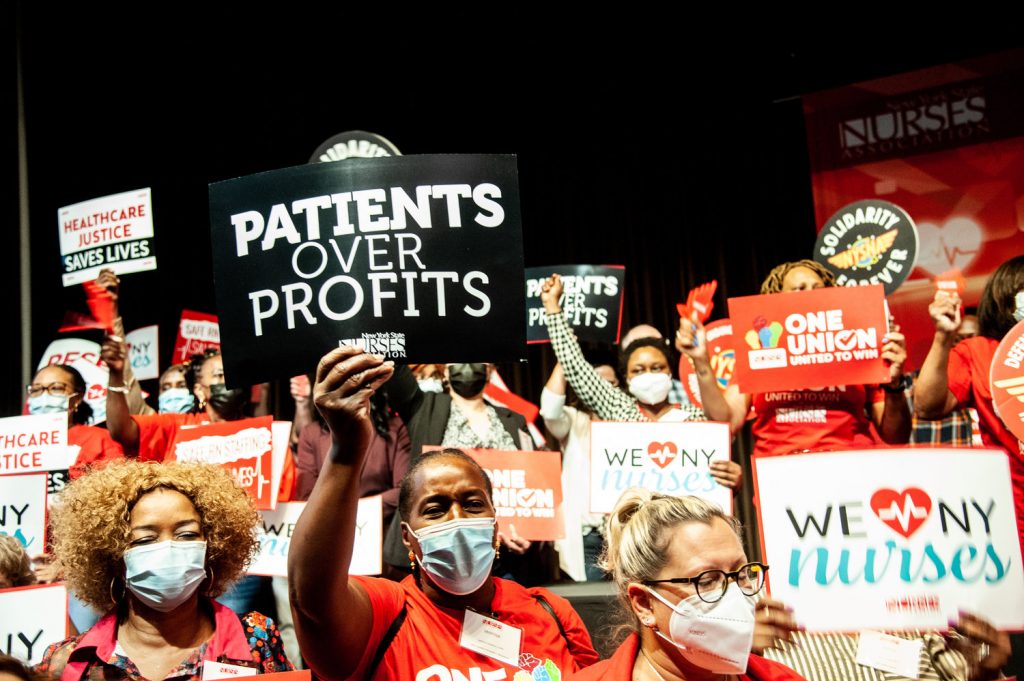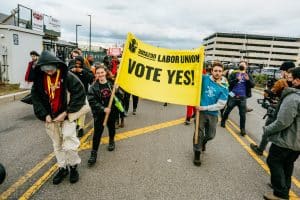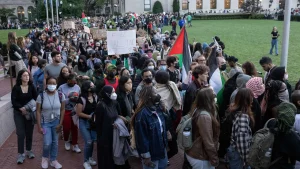Over 10,000 nurses could strike in NYC starting next week. Key among their demands is the fight around safe staffing ratios, which determines the maximum number of patients per on-shift nurse. Nurses are fighting for better working conditions in a setting where staffing has only gotten worse since the beginning of the Covid-19 pandemic. Since the start of the pandemic, thousands of nurses and healthcare workers left the workforce, often from being exhausted, burnt out, and/or traumatized. Many more have also become very ill and/or died from Covid-19, after putting their lives on the line to care for patients. Surveys show large percentages of healthcare workers plan to leave the field in the near future. There are many factors at play, but it is clear that healthcare workers are experiencing a toll trying to care for people in a system that doesn’t care about workers or patients.
As the nursing fight in NYC progresses — and surely more are on the horizon around the country — it is important to review the current NYC fight in its historical context. In 2019, similar to right now, 11,000 New York City nurses with the New York State Nurses Association (NYSNA) were poised for a massive strike. The fight around that strike was eventually co-opted by more conservative forces within the union and the strike was averted. Union officials praised “historic contracts” and big “wins,” but key demands such as safe staffing ratios were never actually won. Lessons from that struggle can help guide the developing struggle today.
Recent Contract Fight History
As the contract fight began in 2019, dozens of nurses at initial bargaining sessions presented first-hand accounts of workplace injuries and violence, the backbreaking pace and volume of patients, missing breaks and meals, precarious retirement with poor healthcare coverage, and the rising pitch of desperation, demoralization, and burnout among nurses. They were sounding the alarm about a healthcare system that prioritized profit over all else, and they were ready to fight face-to-face with the city’s three largest hospital systems — Montefiore, NY Presbyterian, and Mount Sinai — in a battle over working conditions and patient care.
Nurses negotiated for over 6 months with the hospitals, progress was made on some demands, but the key demand of safer staffing was harder to agree on. As always, control over staffing is key for hospitals because of how it relates to controlling labor force and continuing healthcare worker exploitation more generally, so hospital administrations never want to give up control over this aspect of healthcare.
Because it was clear hospitals would not give in easily, many nurses argued for the need to develop a credible strike threat to force employers to the table. In February 2019, nurses overwhelmingly authorized a strike with a 97 percent vote across the facilities. And nurses were pushing for a strike. On March 18, after six months of escalating pressure, NYSNA officials held a press conference denouncing the corporate “Hospital Alliance” for its immutable refusal to bargain over nurse-to-patient ratios and other priority demands. That day, over a roaring and ecstatic crowd of nurses, patients, activists, and local union allies, they presented employers with a 14-day notice to strike on April 2.
Despite voting to strike, the union leadership made little effort to prepare its workers for a credible strike threat, to turn its union from an organization that collaborates with exploitative hospital systems into an organ of class struggle. The union leadership under Executive Director Jill Furillo made no serious moves to establish strike funds or emergency funds for striking nurses; the union did not provide regular education or resources on strike preparation for members; and there were no systems in place that might prove essential in the event of an actual strike, such as guidelines for the formation of strike committees, picket line coordination, member-participation and mobilization tracking systems, platforms for rapid communications among members and leaders, and strategies to build deeper ties with surrounding communities to potentially call on their mass support.
Thus, as workers and management at the largest NYC hospitals reached impasse, as happens during almost every contract cycle, NYSNA officials were sorely unprepared when faced with the impending strike date. At the same time, hospitals went on the offensive, offering deals to NYSNA bargaining teams and claiming that, in exchange, union leaders must immediately call off the strike so employers would not be forced to pay millions in scab wages. This money, the hospitals ludicrously claimed, would be taken from funding for additional staffing.
The bargaining committees of Montefiore, Mount Sinai, Sinai West, Sinai Roosevelt, and NewYorkPresbyterian-Columbia, responsible for over 11,000 nurses, were allotted little more than an hour to deliberate in isolation from their rank-and-file members, shop stewards, and contract action team members. The mediator and attorneys pressed the committees onward, practically with stopwatches in hand.
The nurses’ bargaining committees ultimately voted to lift the strike and negotiate on the employers’ new terms. They informed members only after they made the decision. To the most involved stewards, they explained that they had little time to deliberate before coming to a decision, and no opportunity to consult members and shop-floor leaders.
Most of the 11,000 members who were preparing to strike — many by working overtime and picking up part-time jobs to save money for a strike — heard the news in the days that followed, sometimes through local press and employers’ emails cheerfully announcing that the strike had been lifted: “We are pleased to announce that…the New York State Nurses Association (NYSNA) has withdrawn its 10-day strike notice.”
In the days that followed, NYSNA leaders explained to members that they merely postponed the strike in order to give the process a chance and allow further headway in negotiations. They claimed they had not lost sight of nurses’ burning demands for safe staffing ratios and other priorities. Yet the conversation around safe staffing ratios from leadership waned. And with the strike threat taken away, many nurses logically asked, “why should we expect management to concede to our demands for safe staffing? Why did we agree to pull the strike for bargaining terms that were still a far cry from what we need to staff our hospitals?”
Rank and file nurses at the Mount Sinai hospital, for example, tried to push back by circulating a petition signed by shop-floor leaders, elected stewards, and delegates, urging NYSNA bargaining committees to immediately call for a strike. But the membership was already demobilized. The leadership had effectively disarmed the union in exchange for a nebulous agreement with management. In the end, despite persistent urgings by rank-and-file members, there would be no further serious discussion of a strike.
After this, NYSNA union leadership began negotiating contracts on behalf of the rank and file. With each contract negotiated by private hospital bargaining units, concessions were made to give up one of the main demands of safer staffing ratios. At two of Mount Sinai’s main hospitals, St. Luke’s and Mount Sinai West, most executive committee members equated “staffing grids” with “staffing ratios.” But there were no ratios, and grids were not even outlined in the contract — “to be determined” only after ratification.
Despite the fact that key demands were being given up left and right, union leadership went on the offensive, encouraging rank and file nurses to approve negotiated contracts. Around 15 NYSNA staffers were sent to the respective hospitals to pressure nurses to vote “yes” on the proposed contracts. Typically language was used to present concessions as positives, claiming the contracts were “historic wins.”
Learning From the Past
Many of us know the story of how things went down after this. The Covid-19 pandemic hit with full force, and the safe staffing nurses so desperately fought for was even more clearly needed. But by now it was too late, and healthcare workers struggled to care for increasing numbers of very sick patients with the same staffing levels that were already inadequate. We saw hospitals overcrowding and patients receiving even poorer care than baseline. The healthcare system, built almost exclusively to maximize profit extraction at all costs, could not adapt.
Nurses and other healthcare workers fought to deliver the best care they could under these horrendous conditions. We have seen the pictures of nurses wearing trash bags for PPE, which elicited rage against the healthcare corporation leaderships that were forcing nurses to work under such circumstances during a pandemic. Some even went out on strike to fight for safer working conditions. Around 200 nurses at Montefiore Hospital, for example, struck for safe staffing ratios for two days at the height of the pandemic in 2020.
Meanwhile, hospital management deflected blame, stating they couldn’t predict the shortage of supplies they were faced with—despite the fact that these hospital officials were the same people who refused to give into staffing demands in the previous contract fight before the pandemic was at its height. Hospital administrations also conveniently failed to note how many of them were away hiding safely in their luxury condos while this all went down.
Under these circumstances during the height of the pandemic, and now in hindsight, the nursing fight in 2019 was proven to be even more important. We will never know what would have happened if nurses would have won the ratios they were demanding, but one thing we can predict is there would have been far better outcomes for patients and healthcare workers.
Often when healthcare workers organize to strike, hospital officials go on the offensive by claiming healthcare workers are “abandoning their patients” as a way to curb worker power. But really it is clear to anyone that the only people who abandon patients are hospital executives who create poor staffing in the first place, in a seemingly endless pursuit of profit maximization. Now, looking back on the previous nursing contract struggle, it is not hyperbole to say that a nursing strike and win of safer ratios literally could have saved lives during the pandemic.
From the Past to Today’s Struggle
Today, nurses are again facing the possibility of obtaining important improvements in their working conditions, especially around safe staffing ratios.
But healthcare corporations won’t give away concessions easily. In New York City, hospital administrations are already trying to convince NYSNA union leadership to accept deals without strong safe staffing and patient ratio guarantees at various hospitals (thus far, NewYork-Presbyterian, Maimonides, and Richmond Hospitals have reached tentative agreements). Hospitals frame these deals as “competitive” and “generous” for nurses. But it’s clear, and has always been clear, these corporations will continue putting profits over lives, forcing grueling and dangerous staffing ratios that affect healthcare workers and the community.
As we have covered,
The seeds of revolt amongst U.S. nurses have already begun to sprout. Many nursing strikes occurred in 2022, including a three-day 15,000-person walk-out by the Minnesota Nurses Association. Nurses at Saint Vincent Hospital in Massachusetts were out on strike for almost a year. Becker’s Hospital Review identified 18 separate nursing strikes in total for 2022.
Rank and file nurses must be the ones who decide on what conditions the negotiations should happen and the ones to decide how to use the strike as a method of struggle to fight for their demands.











